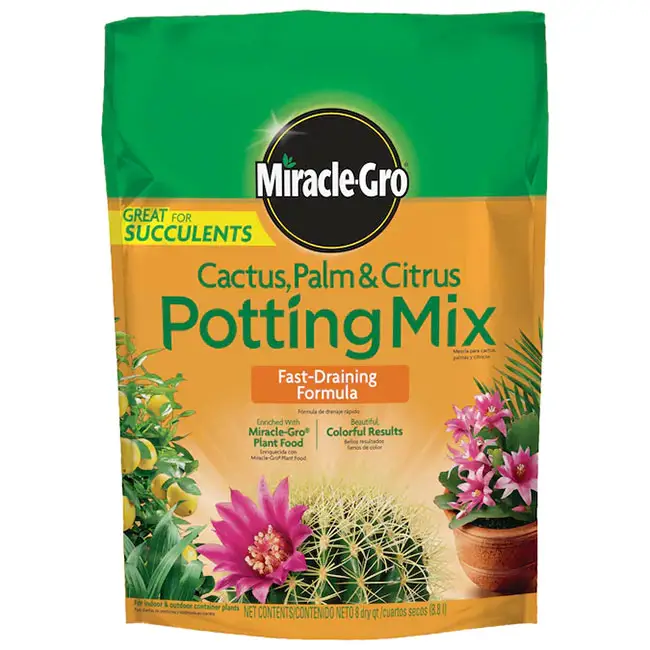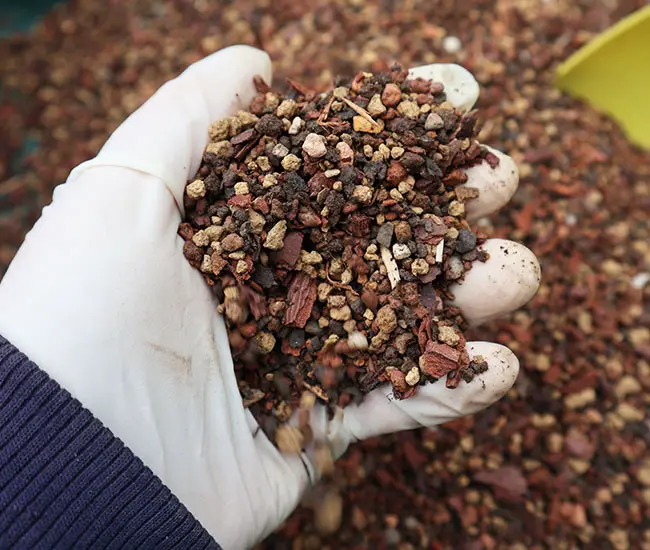
One of the important factors in growing healthy and happy palms is providing them with the best environment possible. Getting the right soil can make a huge difference in the establishment and growth of your newly planted palm.
In general, palm trees like loose, porous soil mixture, that is light well-draining and has a pH level between 6.3 and 6.8. Sand-based soil, like sandy loam, is a good example of the soil type that will provide palms with the best conditions for spreading their roots and nutritional value.
Best Soil For Outdoor Palm Trees
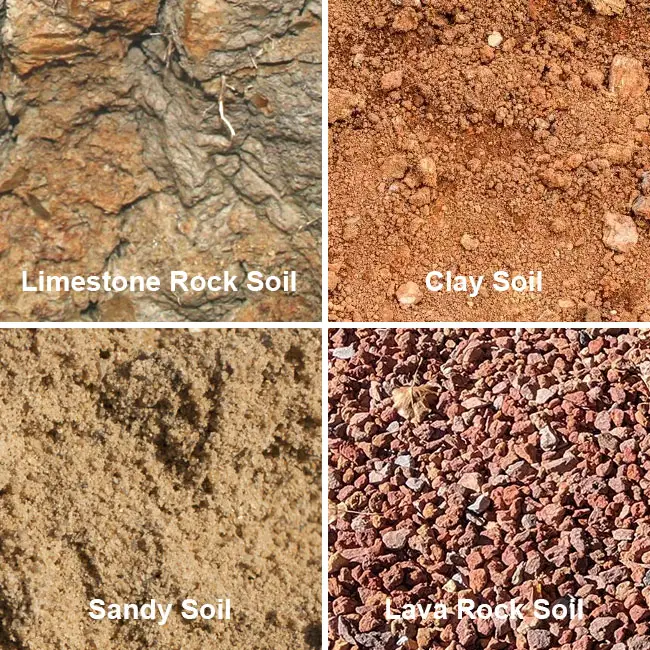
As I’ve mentioned above, palms like light well-draining sand-based soil like sandy loam which consist of 60% sand, 30% silt particles, and 10% clay.
Unlike hard clay soils, it has good drainage, enough clay to provide structure and nutrients, and also is loose enough for the roots to spread.
When planting a palm from the container into the ground, leave as much of its soil on the root ball as possible. That will decrease the transplant shock and recovery time after planting. BTW, I have a whole post about minimizing transplant shock in palm trees.
Amend only the the soil you are using for the backfill. Depending on the soil type in your garden, you should add different components:
- Limestone rock soil. For limestone rock, use one part of #12 grit coarse sand to three parts of your native soil.
- Clay soil. If you have clay soil, loosen the soil as much as you can by breaking large pieces. Add one part of organic matter and one part of #12 grit coarse sand to three parts of the native soil.
- Lava rock soil. For lava rock, a finer grade of lava cinders is a good backfill. Add one part of organic matter to three parts of your native soil.
- Sandy soil. For sandy soil, use one part of organic matter to three parts of your native soil.
Any organic materials available at your local store will work bark mulch, sawdust, cedar bark, aged leaf matter, ground bark, aged lawn cuttings, etc.
The Sphagnum Peat Moss is great for providing excellent drainage. Depending on availability in your area, you will end up with your unique soil mix.
What Is The Right Soil Acidity For Palms
Soil acidity, which is measured in pH unites, can vary ranging from 0 to 14 with pH 7 as the neutral point. The lower the pH of the soil (below 7), the greater the acidity. The higher the pH of soil (above 7), the greater is alkalinity.
While many palms can adapt to wide range of pH and do well in either acidic or alkaline soil, there are some species that do better in one or the other. As a matter of fact, if you plant an alkaline-loving palm in acidic soil, it will not thrive.
During my own experiments with soil, sand-based soil, like sandy loam, that has a pH of 6.3 to 6.8 seems to work for most palm species, especially the tropical ones. Soil acidity can be easily tested with inexpensive soil acidity test strips or a more advanced soil pH meter.
If you soil is too acidic (pH under 6.3 for palm trees), your can use dolomite limestone to increase the pH levels. If you soil is too alkaline, add some organic matter to increase the acidity.
| Palms For Acidic Soil | Palms For Alkaline Soil |
| Foxtail Palm | Bailey Palm |
| Joey Palm | Blue Latan Palm |
| King Palm | Bottle Palm |
| Lipstick Palm | Needle Palm |
| Queen Palm | Date Palm |
Should You Amend Soil When Planting Palm Tree Into The Ground?
The discussions on soil amendments for outdoor palms have been going on for quite some time. Some gardeners think it helps with root development, while others don’t see any benefit.
According to several studies done by universities including Washington State University and University of California, there is no significant benefit of soil amendment in the long run. In addition, they came to the conclusion that it might even cause problems later on.
Here is why. While organic amendments may seem like the proper thing to do, the plant’s roots tend to stay within the amended soil instead of spreading into the surrounding soil. The planting hole acts as a container that keeps the the plant from developing.
While I agree, that overtime the plant will need to get used to the native soil, I also think that soil amendment makes it easier for the palm to develop new roots and establish at the new location.
It also decreased the initial shock from transplanting which can be crucial in determining whether the tree lives or dies. From my experience, there was never any problem with plants after establishment.
I could see this potentially being a problem if you have a hard clay or rocky soil. However, palm roots will have hard time growing into this type of soils anyways and might not survive without any amendments.
Potting Soil Mix for Container Palm Trees
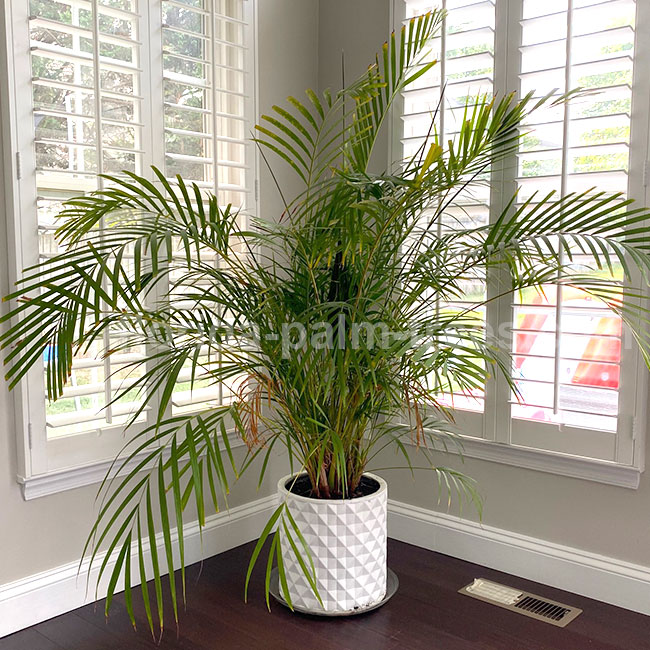
It doesn’t matter whether your container palm is growing outside or inside, it still fully depends on what you provide it with.
While in-ground palms can spread their roots further to reach more water and nutrients if needed, potted palms are limited to boundaries of the container. Therefore, the quality of the potting mix is very important.
A good potting mix should offer stability, necessary nutrients, good water retention, aeration, and excellent drainage. Remember, the more nutrients your soil retains, the less fertilizer it will need.
You can find out what nutrients your palm needs and what is the best fertilizer from my post on how to fertilize palm trees.
I wish I could recommend a ready-to-use potting mix for palm trees that you can easily buy no matter where you live, but that doesn’t exist.
The best way to get a perfect potting mix for palm trees is by combining different components you can find at your gardening store.
Because of a different availability of components in varies regions, your mix could be totally different from mine but both could work well. Remember, there is no ‘universal soil mix’ for all the palm species.
Certain species have their own requirements so your perfect formula will need to be adjusted.
Potting Mix vs Potting Soil
To make it easier to understand the difference between potting mix and potting soil, I’ve created a table for you.
| Potting Mix | Potting Soil |
|---|---|
| Pros: -Cheap -Can be fully organic -Long-lasting -Nutrient-rich | Potting soil might or might not contain garden soil and sometimes sand. |
| Sterile. Safer for plants. | Not sterile. Can contain weeds, seeds, pests and pathogens such as fungi and other diseases. |
| Might contain slow-release fertilizer | Contains compost |
| Pros: -Fluffy texture -Good aeration and drainage -The right nutrient mix -Good water retention | Cons: -More costly -Breaks down over time -Lightweight, problem in a windy location |
| Cons: -More costly -Breaks down over time -Lightweight, problem in windy location | Cons: -Low aeration -Not fluffy enough -Easily compacts and gets water-logged |
Ingredients To Use In A Potting Soil Mix
I know that mixing your own palm soil is a little more involved. But, if you are doing it for multiple plants, it’s a great way to save money and get the perfect soil blend for your particular varieties.
Depending on the availability at your local gardening store, you can use a wide range of amendments in your soil mix. Make sure the soil is not too porous and not too dense.
- Topsoil (Potting soil) is added to the mix for water retention and nutrients. There are seemingly endless varieties of topsoil on the market. Check to see if ingredients are contributing to moisture retention or drainage.
- Sand. For a well-draining soil, it’s important to use a coarse grit sand. Don’t use beach sand nor fine construction sand as it can desiccate palms with salt. The #12 grit coarse sand will work the best in providing drainage.
- Perlite is an amorphous volcanic glass that has a relatively high water content. It is used in soil to improve aeration and to retain water. It also looses dense parts of the soil creating more room for roots to expand and absorb essential nutrients.
- Peat moss is a dead fibrous material that forms when mosses and other living materials decompose in peat bogs. It helps the soil hold nutrients and holds several times its weight in moisture, releasing it to the plants roots as needed. Use it for nutrients and water retention.
- Pumice is an extremely porous volcanic rock with a foamy appearance. It provides excellent aeration to the soil, loosens heavy clay soil and retains moisture. The porous nature of pumice allows it to hold vital nutrients in surface pores helping to regulate fertilizer feedings.
- Dolomite is a type of limestone that is rich in magnesium and calcium carbonate. It also has smaller amounts of several other minerals. It is used to balance out excess acidity in the soil from different organic materials.
- Humus is organic material that forms in soil when plant and animal matter decays. It is a final stage of decomposition, at which point it can’t decompose any further. It is used to increase soil fertility and overall health. Great for aeration, water retention, and nutrient balance.
- Redwood shavings when used in soil mixes, improve its structure and tilth, increase nutrient nutrient-holding capacity of sandy soils, and improve water drainage.
- Other organic materials like bark mulch, sawdust, fir shavings, coconut fiber, cedar bark, aged leaf matter, ground bark, aged lawn cuttings, ground macadamia shells, rice husks and etc.
My Secret Soil Mix Recipe For Potted Palm Trees
After many years of experimenting with different types of soils for potted palms, I came up with the formula that I think works for 90% of the palms.
My secret formula has good water and nutrient retention, root support, and offers great drainage. Here it is:
30% perlite – for aeration and water retention.
30% peat moss – for holding nutrients and moisture retention.
10% topsoil – for nutrients and water retention.
10% coarse sand – for drainage
10% redwood shavings – for drainage and nutrients.
10% pumice – for moisture retention and excellent aeration.
Other Potting Soil Mixes
Many gardeners use just 50% peat moss and 50% perlite which is a very cheap soil mix that will work for seedlings but NOT going to do very well over in the long run. That is why I recommend adding some topsoil and sand to it. Here is what you can use:
40% peat moss
40% perlite
10% coarse sand
10% high quality topsoil
Using Miracle-Gro Potting Mix
If you don’t have time to mix your own potting soil and need to get a ready-to-use potting mix, I would recommend getting a well-draining potting mix with little organic matter, such as Miracle-Gro Cactus, Palm & Citrus Potting Mix.
This mix has an organic base of peat moss and forest products in addition to sand and perlite. It drains well and has a bit of added Potassium, Nitrogen, and Phosphorous which encourages growth without burning the roots.
This is a nice, standard mix for growers who don’t have many plants and who want to save time. It drains fast and stays light and airy.
How To Improve Drainage For Outdoor Palms
Regardless of whether a palm prefers acidic or alkaline soil, it has to drain well. It’s important to test the soil drainage before planting your plant into the ground. Constantly soggy wet soil might lead to root rot and eventually decline of the plant.
You can test the soil by digging a hole and filling it with water. Digg a 12 x 12 inch hole and fill it with water. Then, fill it again. If the water drains within 1-2 hours you have a great drainage. If it takes 12 hours, it’s ok. If the water is still there after a day or two, you have a problem.
But, don’t worry. There are a few ways you can improve it:
- Add sand to the soil mix before planting the palm.
- Place some rocks at the bottom of the hole to help with the drainage. This way, palm roots won’t be sitting in standing water.
- Drill holes at the bottom and the sides of the hole to loosen up the clay soil and to improve the drainage.
- Install a pipe that will take the water away from the plant.
How To Improve Drainage for Potted Palms
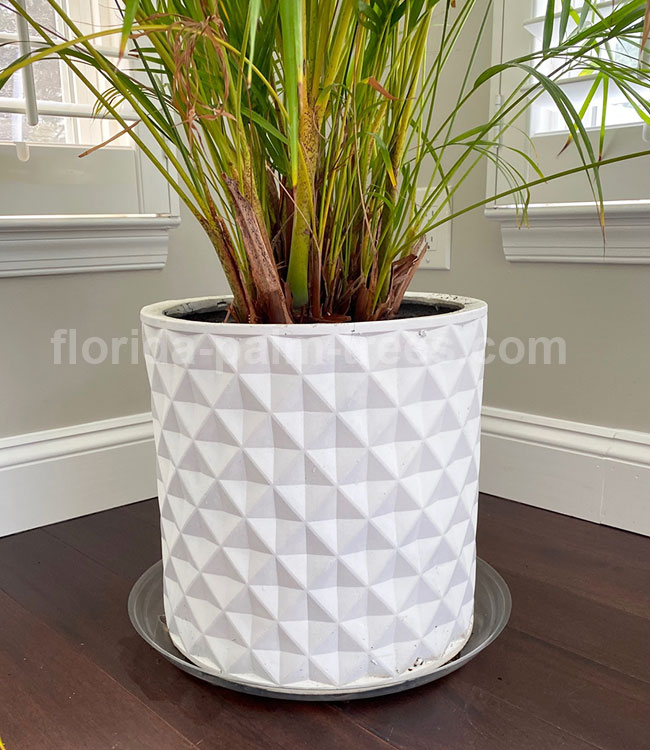
When it comes to container palms, a good drainage is a must. When repotting, always use a pot with drainage hole. If your container doesn’t have a hole, make one or get a different pot.
Some containers come with drainage holes along with a built-in or attached drip pan around the bottom. Others may even have a nice matching ceramic saucer.
I know that most good looking pots come without any holes nor matching saucer. If you find one of those I-can’t-live-without-it pots that lacks a drainage hole, you can do one of the following things.
Use a slightly smaller pot with a drainage hole (usually the black ugly one), and nest it inside your pretty one. Rocks at the bottom of the inner pot will create a space for excess water to drain to.
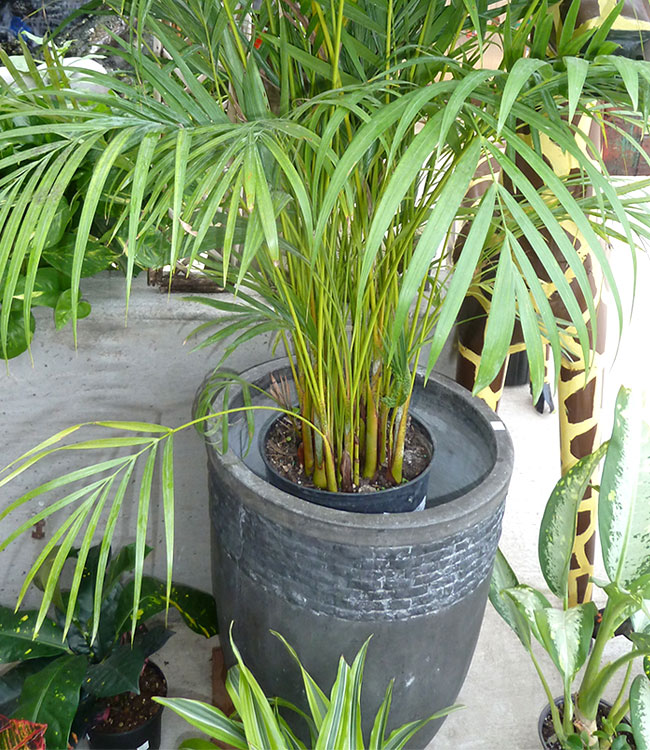
Or, you can drill drainage holes yourself and buy a clear plastic saucer to put underneath. That is exactly what I did for all of my container palms!
I just bought some modern-looking pots and my husband drilled holes in them. Then, I got a bunch of clear plastic saucers from Amazon to match the pot sizes.
I was afraid that the plastic saucer would look tacky and cheap but it turned out to be perfect! Because the saucer is clear, you can barely see it.
Conclusion
As you can see, soil amendment for in-ground palms is quite different from container palms. For outdoor palms, you can slightly amend the soil or skip this step completely.
At the same time, indoor palms require a high-quality soil mix to stay healthy and happy. Because potted palms completely depend on what you provide them with, it’s best to create your own potting mix that is adapted to your species’ needs.
Avoid using random soil from your garden for container soil since unlike store soil it has not been sterilized and might container unwanted pests.

